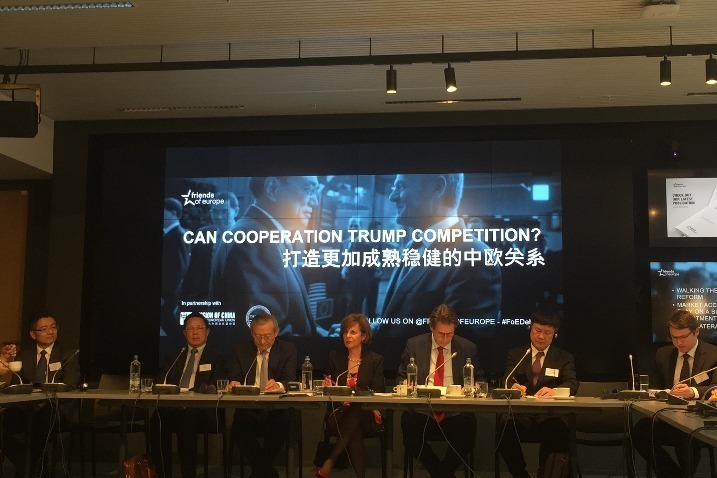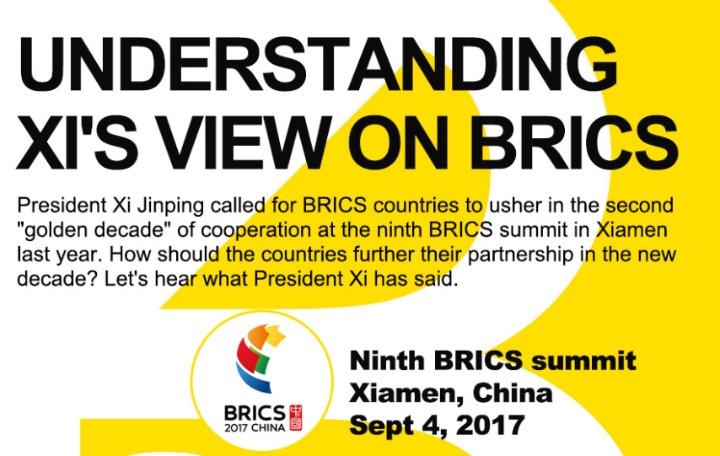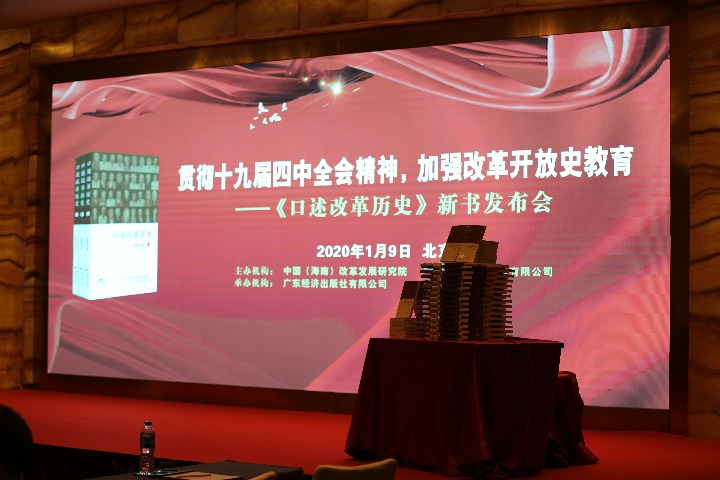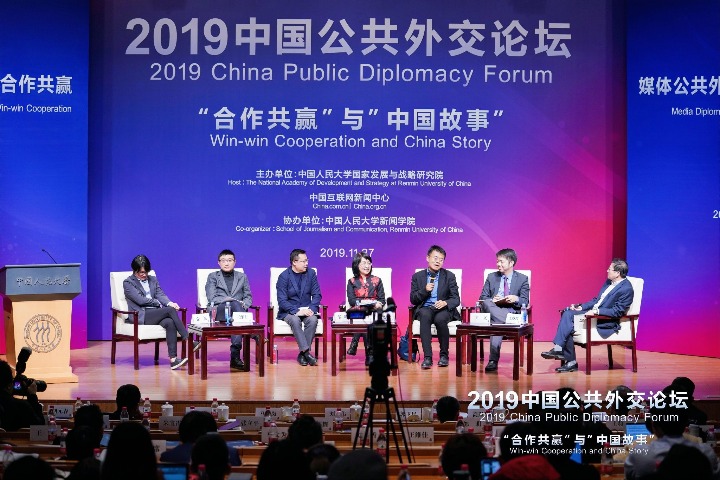Experts assess China’s economic challenges
By Zhang Zhao |
China Watch |
Updated: 2018-05-02 14:59
The recent publication of China's economic data for the first quarter of 2018 attracted a great deal of attention, with many researchers from the State Council's Development Research Center commenting from different viewpoints.
Geographically speaking, Northeast China, which experienced slower industrial growth in recent years, witnessed a steady increase in the first three months of the year, “returning to a positive increase interval”, Jia Shen found.
Another highlight was East China, where industrial growth sped up. Shanghai and Jiangsu and Zhejiang provinces ranked third, sixth and 12th respectively in growth of industrial added value in the first quarter. As the three regions were already in the top five nationwide in terms of per capita GDP, it was not easy for them to achieve such high growth.
“The fast growth of East China may be a reflection of the regional industrial development toward new sectors and new economic models,” Jia said.
Meanwhile, some northern coastal regions, such as Shandong province and Tianjin, saw slower growth. Jia said the reasons may include institutional problems in old economic models, the withdrawal of traditional, lower-end industries and the pessimistic political and economic situation in Northeast Asia.
Zhao Fujun said China’s export structure is improving, noting the rapid increase of exports in general trade, automated data processing equipment and components, and integrated circuits, as well as exports to Brazil, Russia, India and South Africa, the other members of the grouping collectively known as BRICS.
He said economic recovery in the United States and Japan will provide opportunities for Chinese exports this year, but the recovery was slowing down in the eurozone. Renminbi appreciation and the China-US trade conflict could also be challenges.
Liu Tao looked into the services sector. He said the structure of the sector is being optimized, noting faster year-on-year increases in information technology and software services and slower increases in finance and real estate businesses.
Growth in knowledge-intensive services exports outpaced the average for the services sector.
To deepen supply-side reform and improve the quality and benefits of China’s services sector, Liu called for out-of-date regulations be reviewed and revised, the implementation of tax cuts and amendment of the negative list for foreign investors.
The structure of fixed-asset investment is also being optimized, said Xu Shaoyuan, even as its growth rate falls. Private investment rebounded rapidly in the first quarter of this year, outpacing overall investment growth for the first time in two years.
Investment in infrastructure declined sharply. Xu said this will directly impact industries such as steel and cement, but the influence on the overall economy will be small, and it will help avoid a buildup of risky debts.
Zhang Liqun concluded that China “had a good start, but still needs to consolidate its foundation”.
He said the country’s economy showed stable growth, increased benefits and optimized structure, but risks and uncertainties should not be overlooked. Domestically, there were challenges of deleveraging, financial reform and preventing major risks. Globally, there was protectionism and unilateralism, especially a series of sanctions by the US that were having an influence on China’s export-related industries.
The trade conflict between China and the US has sparked self-examination about China’s industrial policies. The Development Research Center’s Wei Jigang said China’s industrial policies have been successful from a strategic point of view.
“Their targets have been basically met over the past 40 years, but the cost is high,” he said, adding that problems include inappropriate government intervention, inefficient allocation of resources and overlapping projects.
He suggested the policies focus on a number of sectors, now and in the future.
First, the future strategic sector, including national defense industry, high-end manufacturing and biotechnology. Second, those sectors that currently have weak global competitiveness and a heavy reliance on imports, such as numerical control machine tools and high-end medical equipment. Third, upgrading of conventional industries such as coal, steel and shipbuilding. Fourth, basic industries concerning the national economy and people’s livelihoods such as strategic resources and infrastructure. Fifth, some sectors where industrial development was weak, such as key basic materials and basic software.
Other areas that also deserved more attention included those where markets could fail, such as security, emergency management, public research and development and public information platforms, he said.
Su Ning, from the Shanghai Academy of Social Sciences, said the US’ recent actions against China’s ZTE and Huawei showed its concern about the advancement of Chinese high-tech companies, while also showing China’s embarrassment that its core technologies were controlled by others.
The sense of “insecurity” was a reflection of developed countries’ thinking on how to maintain their superiority in the division of labor through global trade, he said. The current world economy featured a system in which the developed countries held comparative advantages in technology and research and development, while the emerging economies had comparative advantages in cheap labor and resources.
Su said the theory of comparative advantage had “to some extent, evolved to an economic ideology aiming to curb the emerging economies from rising by locking up their status in the labor-division system”.
Because the model had existed for a long time, developing countries and some developed countries had become dependent on it. So when a developing country tried to upgrade its status in the labor-division system through technological advancement, turning the developed countries’ definite advantages to mere “comparative advantages”, the developed countries were not used to the change, and resorted to “rebalancing” by means beyond normal trade.
To avoid being forced out of the game in high-tech fields, Chinese companies needed to embrace earlier planning on intellectual property, industrial standards and investment.
In an interview with China Radio International, Wei Jianguo, vice-chairman of the China Center for International Economic Exchanges, said Chinese companies had to “prepare for a hard battle”.
“China should no longer hope for anything from the US,” Wei said. “The more we compromise, the worse it will become. If we compromise now, many hesitating countries will follow the US’ suit.
“We must fight back, and fight to the end, to answer the Trump administration’s unilateralism against WTO principles and protectionism against globalization. And we will let them feel the pain.”
In another interview, Wei said China’s solutions include high-quality development through high-quality opening up, change of government functions and improved intellectual property protection.
“It is not necessarily a bad thing to lose some ground in a trade war if we can learn something from the losses,” he said. “For Chinese entrepreneurs, this is a process in which to improve themselves.”
In a trade conflict, China was not afraid of the US, or Europe, alone, said Zhao Ke, from the Party School of the Communist Part of China Central Committee. But it would be much more troublesome if China was confronted by the entire Western world — which might be what is happening now.
He said the US and Europe have different views on trade multilateralism, with the Europeans believing the system is repairable despite problems — including some related to China — and the US believing countries such as China are taking too much of an advantage.
He reviewed the history of Japan after the signing of the Plaza Accord in the mid-1980s and said its later financial bubbles were a result of the Japanese government’s flurried response to the accord. They did not occur in Germany, which also signed the accord, because its government stuck to the financial policies it already had in place.
Zhao said that even if a serious conflict is inevitable, China must not let its existing plans and policies be interrupted by any responses.
Many other scholars have recalled the history of the Plaza Accord when commenting on the current China-US tensions, including Wang Fang from the Liaowang Institute. But she said the global situation has changed, especially since the 2008 economic crisis, and the world’s economic governance system needs to be restructured.
Fundamentally, the China-US row is a conflict of systems, Wang said, and uncertainties in the bilateral relationship are increasing — mainly brought about by the unique unpredictability of US President Donald Trump.
Zhang Zhao is a China Watch researcher.
All rights reserved. Copying or sharing of any content for other than personal use is prohibited without prior written permission.
The recent publication of China's economic data for the first quarter of 2018 attracted a great deal of attention, with many researchers from the State Council's Development Research Center commenting from different viewpoints.
Geographically speaking, Northeast China, which experienced slower industrial growth in recent years, witnessed a steady increase in the first three months of the year, “returning to a positive increase interval”, Jia Shen found.
Another highlight was East China, where industrial growth sped up. Shanghai and Jiangsu and Zhejiang provinces ranked third, sixth and 12th respectively in growth of industrial added value in the first quarter. As the three regions were already in the top five nationwide in terms of per capita GDP, it was not easy for them to achieve such high growth.
“The fast growth of East China may be a reflection of the regional industrial development toward new sectors and new economic models,” Jia said.
Meanwhile, some northern coastal regions, such as Shandong province and Tianjin, saw slower growth. Jia said the reasons may include institutional problems in old economic models, the withdrawal of traditional, lower-end industries and the pessimistic political and economic situation in Northeast Asia.
Zhao Fujun said China’s export structure is improving, noting the rapid increase of exports in general trade, automated data processing equipment and components, and integrated circuits, as well as exports to Brazil, Russia, India and South Africa, the other members of the grouping collectively known as BRICS.
He said economic recovery in the United States and Japan will provide opportunities for Chinese exports this year, but the recovery was slowing down in the eurozone. Renminbi appreciation and the China-US trade conflict could also be challenges.
Liu Tao looked into the services sector. He said the structure of the sector is being optimized, noting faster year-on-year increases in information technology and software services and slower increases in finance and real estate businesses.
Growth in knowledge-intensive services exports outpaced the average for the services sector.
To deepen supply-side reform and improve the quality and benefits of China’s services sector, Liu called for out-of-date regulations be reviewed and revised, the implementation of tax cuts and amendment of the negative list for foreign investors.
The structure of fixed-asset investment is also being optimized, said Xu Shaoyuan, even as its growth rate falls. Private investment rebounded rapidly in the first quarter of this year, outpacing overall investment growth for the first time in two years.
Investment in infrastructure declined sharply. Xu said this will directly impact industries such as steel and cement, but the influence on the overall economy will be small, and it will help avoid a buildup of risky debts.
Zhang Liqun concluded that China “had a good start, but still needs to consolidate its foundation”.
He said the country’s economy showed stable growth, increased benefits and optimized structure, but risks and uncertainties should not be overlooked. Domestically, there were challenges of deleveraging, financial reform and preventing major risks. Globally, there was protectionism and unilateralism, especially a series of sanctions by the US that were having an influence on China’s export-related industries.
The trade conflict between China and the US has sparked self-examination about China’s industrial policies. The Development Research Center’s Wei Jigang said China’s industrial policies have been successful from a strategic point of view.
“Their targets have been basically met over the past 40 years, but the cost is high,” he said, adding that problems include inappropriate government intervention, inefficient allocation of resources and overlapping projects.
He suggested the policies focus on a number of sectors, now and in the future.
First, the future strategic sector, including national defense industry, high-end manufacturing and biotechnology. Second, those sectors that currently have weak global competitiveness and a heavy reliance on imports, such as numerical control machine tools and high-end medical equipment. Third, upgrading of conventional industries such as coal, steel and shipbuilding. Fourth, basic industries concerning the national economy and people’s livelihoods such as strategic resources and infrastructure. Fifth, some sectors where industrial development was weak, such as key basic materials and basic software.
Other areas that also deserved more attention included those where markets could fail, such as security, emergency management, public research and development and public information platforms, he said.
Su Ning, from the Shanghai Academy of Social Sciences, said the US’ recent actions against China’s ZTE and Huawei showed its concern about the advancement of Chinese high-tech companies, while also showing China’s embarrassment that its core technologies were controlled by others.
The sense of “insecurity” was a reflection of developed countries’ thinking on how to maintain their superiority in the division of labor through global trade, he said. The current world economy featured a system in which the developed countries held comparative advantages in technology and research and development, while the emerging economies had comparative advantages in cheap labor and resources.
Su said the theory of comparative advantage had “to some extent, evolved to an economic ideology aiming to curb the emerging economies from rising by locking up their status in the labor-division system”.
Because the model had existed for a long time, developing countries and some developed countries had become dependent on it. So when a developing country tried to upgrade its status in the labor-division system through technological advancement, turning the developed countries’ definite advantages to mere “comparative advantages”, the developed countries were not used to the change, and resorted to “rebalancing” by means beyond normal trade.
To avoid being forced out of the game in high-tech fields, Chinese companies needed to embrace earlier planning on intellectual property, industrial standards and investment.
In an interview with China Radio International, Wei Jianguo, vice-chairman of the China Center for International Economic Exchanges, said Chinese companies had to “prepare for a hard battle”.
“China should no longer hope for anything from the US,” Wei said. “The more we compromise, the worse it will become. If we compromise now, many hesitating countries will follow the US’ suit.
“We must fight back, and fight to the end, to answer the Trump administration’s unilateralism against WTO principles and protectionism against globalization. And we will let them feel the pain.”
In another interview, Wei said China’s solutions include high-quality development through high-quality opening up, change of government functions and improved intellectual property protection.
“It is not necessarily a bad thing to lose some ground in a trade war if we can learn something from the losses,” he said. “For Chinese entrepreneurs, this is a process in which to improve themselves.”
In a trade conflict, China was not afraid of the US, or Europe, alone, said Zhao Ke, from the Party School of the Communist Part of China Central Committee. But it would be much more troublesome if China was confronted by the entire Western world — which might be what is happening now.
He said the US and Europe have different views on trade multilateralism, with the Europeans believing the system is repairable despite problems — including some related to China — and the US believing countries such as China are taking too much of an advantage.
He reviewed the history of Japan after the signing of the Plaza Accord in the mid-1980s and said its later financial bubbles were a result of the Japanese government’s flurried response to the accord. They did not occur in Germany, which also signed the accord, because its government stuck to the financial policies it already had in place.
Zhao said that even if a serious conflict is inevitable, China must not let its existing plans and policies be interrupted by any responses.
Many other scholars have recalled the history of the Plaza Accord when commenting on the current China-US tensions, including Wang Fang from the Liaowang Institute. But she said the global situation has changed, especially since the 2008 economic crisis, and the world’s economic governance system needs to be restructured.
Fundamentally, the China-US row is a conflict of systems, Wang said, and uncertainties in the bilateral relationship are increasing — mainly brought about by the unique unpredictability of US President Donald Trump.
Zhang Zhao is a China Watch researcher.
All rights reserved. Copying or sharing of any content for other than personal use is prohibited without prior written permission.









